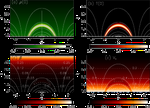Solar Physics ( IF 2.8 ) Pub Date : 2024-03-22 , DOI: 10.1007/s11207-024-02285-z Tongjiang Wang , Leon Ofman , Stephen J. Bradshaw

|
Recent observations of reflected propagating and standing slow-mode waves in hot flaring coronal loops have spurred our investigation into their underlying excitation and damping mechanisms. To understand these processes, we conduct 2.5D magnetohydrodynamic (MHD) simulations using an arcade active region model that includes a hot and dense loop. Our simulations allow for in-depth parametric investigations complementing and expanding our previous 3D MHD modeling results. We excite these waves using a large-amplitude flow pulse applied at one footpoint of the loop in two distinct models as motivated by observations from the Solar Dynamics Observatory/Atmospheric Imaging Assembly (SDO/AIA). The first model (Model 1) incorporates classical compressive viscosity coefficient, whereas the second model (Model 2) adopts a 10 times enhanced viscosity coefficient. We obtain the following major results: (1) Our 2.5D MHD simulations reinforce previous conclusions derived from 1D and 3D MHD models that significantly enhanced viscosity is crucial for the rapid excitation of standing slow waves with damping times consistent with observations by Wang et al. (2015). (2) We uncover that nonlinearity in Model 1 delays the conversion of a reflected propagating wave into a standing wave. In contrast, Model 2 exhibits a much weaker influence of nonlinearity on the excitation time of standing waves thanks to the suppression of these effects by enhanced viscosity. (3) Our results reveal that the transverse temperature structure has more influence on wave behavior than the density structure. In Model 1, increased loop temperature contrast significantly enhances wave trapping within the structure, mitigating the impact of temperature-dependent viscous damping. Conversely, in Model 2 the impact of temperature structure on wave behavior weakens in comparison to the effect of viscosity. (4) Model 1 displays evident nonlinear coupling to the fast and kink magnetoacoustic waves and pronounced wave leakage into the corona. Model 2 exhibits significantly weaker effects in this regard. Analyzing three observed wave events by SDO/AIA aligns with Model 2 predictions, providing further support for the substantial viscosity increase. Our 2.5D study unravels the complex interplay of wave-flow phenomena and nonlinear processes in coronal loops, extending our previous 1D modeling results to incorporate more realistic loop geometry. This provides insights into scenarios where 3D effects may be neglected, thereby enhancing our understanding of the intricate dynamics of the solar corona.
中文翻译:

探索耀斑日环中的驻波和反射慢模波:使用 2.5D MHD 建模的参数研究
最近对热耀斑日冕环中反射传播和慢模驻波的观察促使我们对其潜在的激励和阻尼机制进行研究。为了理解这些过程,我们使用包含热密集环路的街机活动区域模型进行 2.5D 磁流体动力学 (MHD) 模拟。我们的模拟可以进行深入的参数研究,补充和扩展我们之前的 3D MHD 建模结果。我们在太阳动力学天文台/大气成像组件(SDO/AIA)的观测结果的推动下,在两个不同的模型中,在环路的一个足点施加大振幅流脉冲来激发这些波。第一个模型(模型 1)采用经典的压缩粘度系数,而第二个模型(模型 2)采用 10 倍增强的粘度系数。我们获得了以下主要结果:(1)我们的 2.5D MHD 模拟强化了先前从 1D 和 3D MHD 模型得出的结论,即显着增强的粘度对于快速激发驻慢波至关重要,其阻尼时间与 Wang 等人的观察一致。 (2015)。 (2) 我们发现模型 1 中的非线性延迟了反射传播波向驻波的转换。相比之下,由于增强的粘度抑制了这些影响,模型 2 表现出的非线性对驻波激发时间的影响要弱得多。 (3)我们的结果表明横向温度结构对波浪行为的影响比密度结构更大。在模型 1 中,增加的回路温度对比度显着增强了结构内的波捕获,从而减轻了温度相关粘性阻尼的影响。相反,在模型 2 中,与粘度的影响相比,温度结构对波浪行为的影响减弱。 (4) 模型 1 显示出与快速和扭结磁声波的明显非线性耦合以及明显的波泄漏到日冕中。模型 2 在这方面表现出明显较弱的效果。 SDO/AIA 分析观察到的三个波浪事件与模型 2 的预测一致,为粘度的大幅增加提供了进一步的支持。我们的 2.5D 研究揭示了日冕环中波流现象和非线性过程的复杂相互作用,扩展了我们之前的一维建模结果,以纳入更真实的环几何形状。这提供了对可能忽略 3D 效应的场景的见解,从而增强了我们对日冕复杂动力学的理解。



























 京公网安备 11010802027423号
京公网安备 11010802027423号